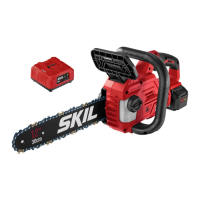32
Depth-Gauge Clearance
1.
The depth gauge should be maintained at a clearance of 0.025 in. (0.6 mm), as shown in
Fig. 35. Use a depth-gauge tool (available separately) to check the depth-gauge clearances.
2.
Check the depth-gauge clearance every time the chain is led. Use a at le and a depth-
gauge jointer (both available separately) to lower all gauges uniformly (Fig. 36). Depth-
gauge jointers are available in 0.020 – 0.035 in. (0.5 – 0.9 mm). Use a 0.025 in. (0.6 mm)
depth-gauge jointer.
Depth gauges must be adjusted with the at le in the same direction the adjoining cutter
was led with the round le. Use care not to contact the cutter face with the at le when
adjusting depth-gauges.
Fig. 35
Depth Gauge Clearance
0.025" (0.6 mm)
Fig. 36
Depth Gauge
Jointer
Flat File
Guide-Bar Maintenance
When the guide bar shows signs of wear,
reverse it on the saw to distribute the wear for
maximum bar life. The bar should be cleaned
every day of use and checked for wear and
damage. Feathering or burring of the bar rails
is a normal process of bar wear. Such faults
should be smoothed with a le as soon as they
occur. A bar with any of the following faults
should be replaced.
•
Wear inside the bar rails which permits the
chain to lay over sideways.
•
Bent guide bar.
•
Cracked or broken rails.
•
Spread rails.
The guide bar has a sprocket at its tip. The sprocket must be lubricated weekly with a grease
syringe to extend the guide-bar life. Use a grease syringe to lubricate weekly with chain oil by
means of the lubricating hole (Fig. 37). Turn the guide bar and check that the lubrication holes
and chain groove are free from impurities.
Fig. 37
Sprocket in
Guide Bar Tip
Lubricating Hole

